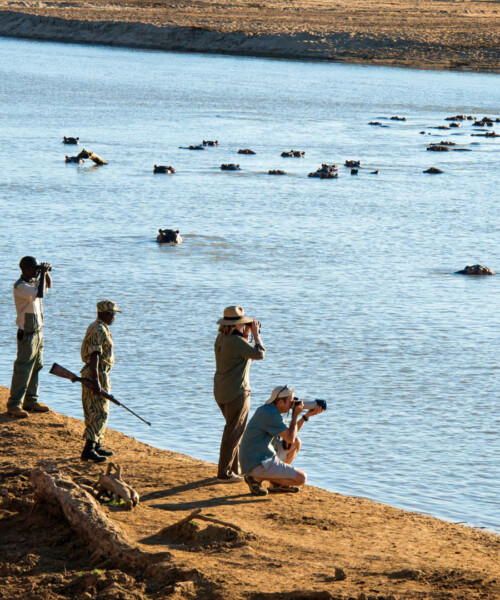As 2020 marks 70 years since conservationist Norman Carr pioneered his walking safaris in the South Luangwa Valley, there’s no better time to discover this wild pocket of Zambia on foot. “To me, when you’re on a game drive, you see Africa. When you’re on foot, you feel Africa,” my guide, Andrew, says to me as we clamber across the mounds of a dry riverbed to watch the sun set while two lions sleep on the far bank. “When you’re in the vehicle, you have a sighting. When you’re on foot, you have an experience.” South Luangwa National Park has long been associated with the walking safari. Bordered by a steep escarpment to the west, with the Luangwa River running along the eastern side, this 3,500-square-mile expanse of protected land in eastern Zambia provides a habitat for what’s said to be one of Africa’s greatest wild-life concentrations. Elephants, hippos, lions, leopards, and wild dogs roam the woodlands, sandy floodplains, grasslands, and riverine forests, with native animal species such as Crawshay’s zebra existing only here.

South Luangwa offers frequent sightings of unique species, including Thornicroft’s giraffe.
It was in 1950 that the British conservationist Norman Carr began making his mark here, petitioning the paramount chief of the Luangwa Valley’s Kunda people to set aside a portion of tribal land as a game reserve. His vision for conservation through tour-ism led him to set up Zambia’s first safari camp, ultimately introducing ecotourism to the region.
With the debut of the first game-viewing camp, South Luangwa became the setting for photographic and walking safaris, from which profits went back to the community. This all hearkened to Carr’s original dream of protecting the special wilderness’s future by making sure that the local population benefited from wildlife conservation, shaping the ecotourism model now seen across much of Africa. That first step led to the founding of Norman Carr Safaris—now Time + Tide—which today runs five conservation-focused camps in the South Luangwa Valley. Showing the historic significance of walking safaris in this park, the camps and lodges belonging to a series of safari operators still take guests out to explore the land on foot. I’m staying at Puku Ridge, which is the latest lodge to make its debut here.

Tranquil sleeping quarters at Time + Tide Luwi.
This past October, the remote safari camp reopened after a complete transformation from the ground up to elevate its level of luxury and ensure optimum sustainability. The new owner, Chichele Safaris, now operates the property in partnership with longtime safari specialist Chiawa Safaris, known for pioneering a number of conservation initiatives in the country.

Newly opened Puku Ridge is raised above the ground to have minimal impact on the land.
Childhood memories of venturing into the bush with Norman Carr have had a lasting impression on Chiawa Safaris’ owner, Grant Cumings. “Being on foot is about the silence,” he tells me from the panoramic deck of the new lodge. “It’s about being on nature’s terms. When you see an elephant on foot, there’s that frisson and edgy naturalness that lives with you forever. Moving at a slower pace means you’re able to see the tracks, droppings, and insects, and hear the birdcalls. You notice what you otherwise wouldn’t see, hear, or smell. You get the whole inside story of the bush. You get a much more detailed look at how nature works.”
With the reopening of Puku Ridge, Chiawa Safaris is now among the safari operators that are giving guests a taste of the walking safari experience. And Time + Tide continues to offer journeys through the bush from its South Luangwa properties: Chinzombo, Luwi, Nsolo, Kakuli, and Mchenja. As you set out single file through a shaded forest, past water holes, and across the dry earth behind a ranger and guide, baboons rest beneath the trees, hippos bob below the surface of the water, and hornbills fly overhead. Your senses tune in to the sounds around you, and paw prints indicate where animals passed through the bush before you arrived.
Since no walking safari is quite the same as another, combining time at the park’s historic camps with a stay at its newest arrival gives you your own unique experience with this wild landscape and its story.







































